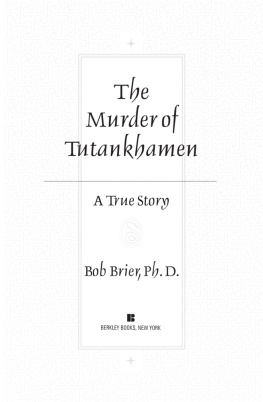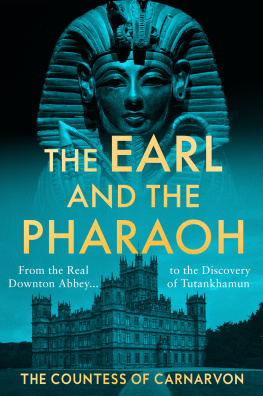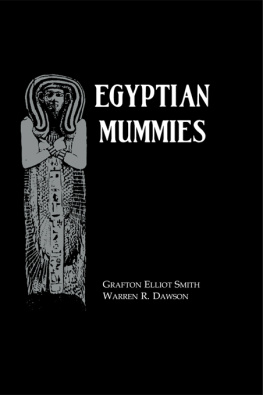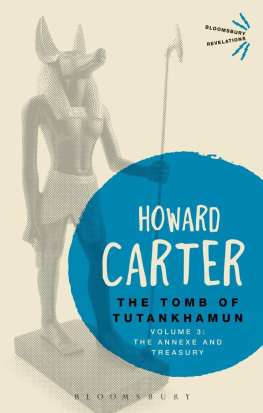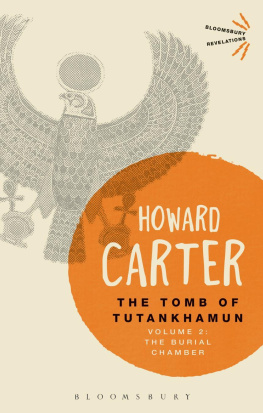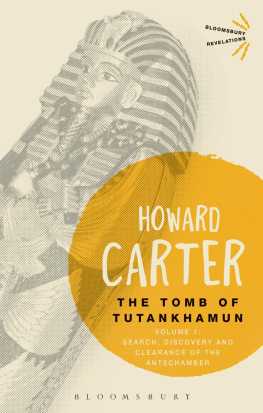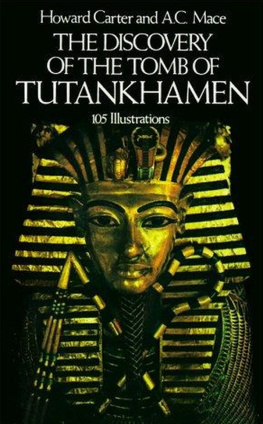TUTANKHAMEN
AND THE DISCOVERY OF HIS TOMB
BY THE LATE
EARL OF CARNARVON and
Mr HOWARD CARTER
BY
G. ELLIOT SMITH
M.A., M.D., Litt.D., F.R.S.
Professor of Anatomy in the University of London
AUTHOR OF
THE ANCIENT EGYPTIANS, THE ROYAL MUMMIES,
THE EVOLUTION OF THE DRAGON, ETC.
With 22 Illustrations, 2 Maps,
and a Coloured Frontispiece Tribute to Tutankhamen
LONDON
GEORGE ROUTLEDGE & SONS, LTD.
NEW YORK: E. P. DUTTON & CO.
1923
PRINTED IN GREAT BRITAIN BY
THE EDINBURGH PRESS, 9 AND 11 YOUNG STREET, EDINBURGH.
CONTENTS
| | PAGE |
|---|
|
|
CHAPTER | | |
|---|
I. | |
II. | |
III. | |
IV. | |
| Embalming and ImmortalityEarly BeliefsThe Dawn of CivilizationGiving Life to the DeadSuccess after Twenty CenturiesThe King and Osiris. |
V. | |
| Tomb-Robbers ConfessionsHiding the Mummies. |
VI. | |
VII. | |
VIII. | |
PREFACE
During the period when the newspapers were publishing daily reports of the progress of the work in Tutankhamens tomb and Mr Harry Burtons photographs, which gave us so vivid an impression of the objects that were being found, I wrote for the Daily Telegraph a series of articles discussing the wider significance of the startling discoveries. They did not describe the tomb itself or the wonderful collection of funerary equipment, but were merely a general commentary on the meaning of the information being given by the reporters from the Theban necropolis. Nor was any attempt made to collect the few facts concerning Tutankhamen himself, or even to discuss the events of his time. The exploration of the Valley of the Tombs of the Kings, for which the late Lord Carnarvon and Mr Howard Carter were responsible, had brought to light the tomb of the youthful nonentity Tutankhamen, which sheds a dazzling searchlight on one particular phase of the history of civilization thirty centuries ago. What I set out to attempt was to interpret the deeper meaning of those Egyptian beliefs which found such brilliant expression in the luxuriously extravagant equipment of his tomb.
I have been urged to collect these articles into the more convenient form of this little book. As they were merely comments on the descriptions of the actual tomb and its contents the separate issue of these topical and ephemeral notes seemed at first to lack any justification, but I have received so many requests for information and guidance that I thought it might serve some useful purpose to redraft my articles and give such bibliographical references as would help the general reader to understand the results that have so far been attained and to appreciate the value of the more important discoveries that next seasons work will certainly reveal.
I have used the pharaohs name Tutankhamen as the title of this book merely as a label to suggest the circumstance that called it into being. But I have written an introductory chapter to give an account of what is known of him and his times.
BIBLIOGRAPHICAL NOTE
The only accurate and reliable account that has ever been given of the Egyptian funerary practices and their significance is Dr Alan Gardiners introductory memoir on The Tomb of Amenemht (illustrated by Nina de Garis Davies) which was published in 1915 under the auspices of the Egypt Exploration Fund (now Society).
Dr Gardiner describes the actual condition of affairs found in a private Theban tomb of the eighteenth dynasty (in the reign of Thothmes III, about a century earlier than Tutankhamen); and in the light of his intimate knowledge and understanding of the literature of the period, he interprets the meaning of the arrangement of the tomb and especially of the scenes and inscriptions sculptured and painted upon the walls, which Mrs de Garis Davies has reproduced with such skill and accuracy. This unique work is indispensable to anyone who wants to read what the ancient Egyptians themselves actually wrote to express their beliefs or interpret their customs. Professor James H. Breasteds History of Egypt and Development of Religion and Thought in Ancient Egypt are the best guides to a knowledge of the history and religion of ancient Egypt. The late Sir Gaston Masperos Egyptian Art (London, 1913) contains a great deal of information directly relevant to the interpretation of objects in Tutankhamens tomb. But Mr Burtons photographs of Tutankhamens funerary equipment give a new interest and value to Birchs edition of Sir Gardner Wilkinsons The Manners and Customs of the Ancient Egyptians (London, 1878), for many of the objects and funeral scenes depicted in that remarkable book enable us to form a mental picture of the Valley of the Tombs as the funeral of Tutankhamen wound its way to the place where Mr Howard Carter has just brought to light so many articles closely analogous to those depicted in Birchs and Wilkinsons book.
All the information at present available concerning the life of Tutankhamen and Horemheb, his successor once removed, was collected and published (in 1912) by the late Sir Gaston Maspero, The Tombs of Harmhabi and Touatnkhamanou (Theodore M. Davis Excavations).
The other volumes of reports published by Mr Theodore Davis are valuable for reference and comparison in studying the results of the exploration of Tutankhamens tomb. The two volumes, The Tomb of Iouiya and Touiyou (1907) and The Tomb of Queen Tiyi (1910) are specially important, and relevant to the discoveries in Tutankhamens tomb. Mr Arthur Weigalls book The Life and Times of Akhnaton gives a popular and romantic picture of his conception of the history of the times of Tutankhamen and his father-in-law.
TUTANKHAMEN
CHAPTER I
INTRODUCTORY
Never before in the history of archological inquiry has any event excited such immediate and world-wide interest as Mr Howard Carters discovery of Tutankhamens tomb in November 1922. Very little is known as yet of the king himself, but twelve months hence no doubt his mummy will give up its secrets and perhaps the story of his life will be revealed. But at the moment he is supposed to have been merely a colourless youth, who reigned for a few years only, and achieved such notoriety as is associated with his name by virtue of weakness rather than strength of character. For his religious and political opinions seem to have been as plastic as those of the famous Vicar of Bray, adapting themselves with facility to his changing environment. The objects so far found in his tomb do not add very materially to our knowledge of history.



